Top 10 Patterns from Lake Cumberland
Beating the bank with reaction baits was key to fishing on Championship Saturday

In the late fall on Lake Cumberland, smallmouth can be pretty easy targets for anglers willing to cover a lot of water up shallow on the rocky, boulder-strewn shorelines that comprise most of the highland reservoir in Southern Kentucky. In the Toyota Series Championship last week, that meant beating the banks with a variety of reaction baits.
Apart from Dakota Ebare (who leaned on a Carolina rig) and winner Chris Malone (who utilized a tail spinner in a fairly unorthodox way – read more about that pattern here), Lake Cumberland staples like the SPRO RkCrawler 55 did most of the heavy lifting.
From the ample creeks found all along Cumberland’s shoreline to main-lake banks, catching both numbers and quality was as simple as finding the right stretches of shoreline and covering plenty of water.
Here’s a breakdown of how the top 10 made their money in the Toyota Series Championship.
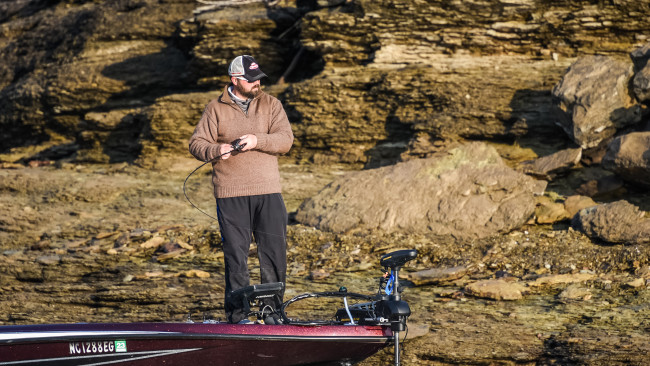
2. Lineback connects on Hail Mary on final day
For most of the tournament, Mount Airy, North Carolina pro Cameron Lineback targeted “do-nothing” banks that featured transitional areas – areas where the rocky shoreline appeared to turn to just dirt. As long as those banks were near enough to a main channel swing with a small depth change, that’s where Lineback got bit.
That worked for two days, but day three turned into what Lineback describes as an “absolute disaster.” With one fish as the day was coming to a close, he had to do something drastically different.
“I ran into a creek up here [near takeoff] at the end of the day, and in 30 minutes, I caught four keepers,” he says. “We were way down the lake and I just decided to come up here in this creek where I got a couple bites in practice. I slid up on a windy bank and caught one on a Speed Trap, and I just threw it the last hour of the day and probably caught nine or 10 fish, and four of them happened to keep.”
The creek Lineback references is Pitman Creek, which is the first creek off the main lake running south from takeoff. He covered half the creek in 40 minutes, by his estimation, which was more than enough time to tally 10-4 for the day and very nearly overtake eventual winner Chris Malone.
Every fish Lineback caught throughout the tournament came on a crystal crawdad Luhr Jensen Speed Trap, save for one he caught flipping a Zoom Ultra Vibe Speed Craw on day one. Otherwise, he just tied his Speed Trap (modified with No. 4 Gamakatsu wide gap trebles) to 12-pound-test Seaguar InvizX fluorocarbon spooled on a Lew’s reel and paired with 7-foot, 6-inch medium-heavy Denali KOVERT Lite cranking rod and went to work.
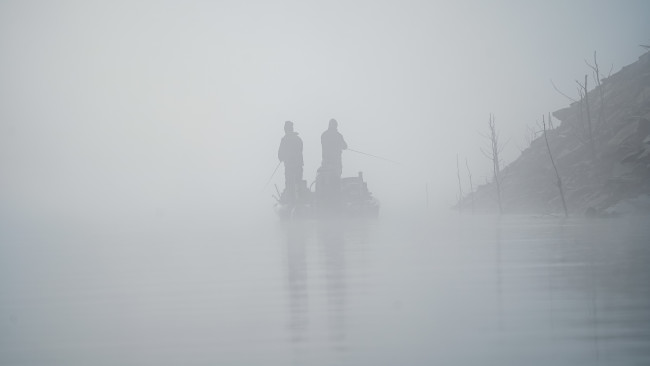
3. Boggs avoids the crowds, runs up the river
Drew Boggs earned a top 10 at Dale Hollow in the final Toyota Series Central Division event of the season by running way up the Obey River to target fish no one else gave a second thought to. It worked well on that highland reservoir on the Cumberland River, so why not another?
Boggs spent his time in the Big South Fork of the Cumberland, the opposite direction from takeoff the rest of the field ran throughout the event. There, where the river narrowed, Boggs spent his time on the bank, cranking up 37-4 to secure his third-place finish.
“When you get to bigger water, it’s got longer points, brush piles, more options and flatter areas [fish] can get to,” he says. “When you get up a river, it’s just kind of a river ditch – they’re up on the bank. The fish that do pull up [to the bank], it makes them easier to target.
“I’m kind of a river guy. I like to get up into areas that don’t see many boats and also has current, and there’s a little current up here in this river. Dale Hollow, I went up so far there was current there too. It’s just something that positions the fish.”
Boggs spent all his time with a cranking rod in hand. He used a Lew’s reel with 15-pound-test fluorocarbon to wind a Strike King 1.5 squarebill crankbait in orange belly craw to cover water and catch his fish.

4. Ebare leans on the old ball and chain
Tackle Warehouse Pro Circuit pro Dakota Ebare specializes in finding things no one else thinks to try. In this case, that meant dragging a Carolina rig on secondary points near the mouth of Cumberland’s creeks on the lower end of the lake.
“I decided to fish down the lake because I felt like that was the was best water to find as many smallmouths as I could,” he says. “I knew smallmouth would probably dominate this event and win. I figured I would spend my tournament down there because there’s a lot of different structure and really good stuff for that type fishing. It’s more conducive to the smallmouth.”
Ebare’s fish were setting up on points, but while many anglers were fishing main-lake points or in the backs of creeks, the Denham Springs, Louisiana pro focused on the second and third points within those creeks. Those points “stair-stepped down,” he says, with big chunk rock being the primary cover.
“To me, it’s pretty simple,” he adds. “It was something that got overlooked. It was a really cool ambush deal.”
Ebare chose the Carolina rig because he surmised that his fish were eating crawfish, and they were flat-out eating his crawfish-imitating C-rig. Opting to stick with just the Carolina rig all week, Ebare employed a 7-foot, 11-inch extra-extra-heavy Hammer rod paired with a Shimano reel spooled with 20-pound-test line and a 15-pound-test leader. He used a 1-ounce weight for the setup and tipped it with a Zoom Ultra Vibe Speed Craw in the cinnamon purple color.
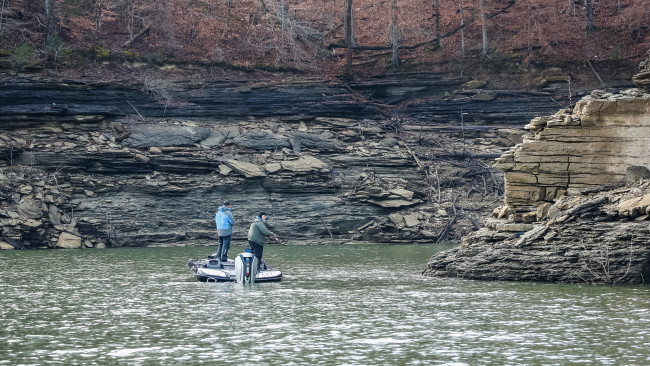
5. Olliverson focuses on main-lake transition banks
Eric Olliverson spent all his time in the mid-lake area targeting main-lake shoreline that featured any kind of transition – boulders to gravel, fist-sized rocks to clay – and paying close attention to the small indents in the shoreline.
The key to finding the right areas, though, was water color and clarity.
“I was looking for the pattern within the pattern,” he says. “The first couple days of practice, I tried to make the clear water go and I couldn’t. I wanted to stay up there [in the mid-lake area]. I felt like that was probably where it was going to be won. That little bit more stained, off-color water in the mid-lake area up here to the river, it seemed like it was easier to get bit.
“In the mornings and on darker days, I would head up towards the little bit clearer water and work my way down.”
Olliverson employed a handful of different reaction baits to tally his 34-15 for the event: a 6th Sense Curve 55 crankbait, a Z-Man/Evergreen ChatterBait Jack Hammer and a pair of spinnerbaits from War Eagle and Trophy Bass Company (3/4- and 1-ounce) tipped with a 6th Sense Divine Swimbait. For every bait, Olliverson opted for 6-foot, 11-inch 6th Sense Lux rods, Team Lew’s Lite reels and 10-pound-test Vicious Fluorocarbon line.

6. Mitchell targets bass chasing bait
Kurt Mitchell knows his way around a smallmouth fishery. That’s why it’s no surprise he found something a little different than everyone else who made the top 10 at Cumberland.
Focusing his efforts primarily on points in creeks in the mid-lake area, Mitchell spent a couple days finding areas in those creeks where bass were pushing bait up on the bank. It was a “timing deal,” he says of his pattern, which held up nicely for the first two days.
On day three, though, Mitchell’s fish decided to stay out in the middle of the creek, where he saw them breaking and chasing bait but couldn’t get them to chase his baits instead. As such, he ran south to Pumpkin Creek – a little narrower creek than most, which gave the bait less room to hide – and was able to scrounge up four keepers for 10-4 to move up into sixth place for the tournament.
Mitchell’s bait of choice throughout the event was a trio of umbrella rigs featuring a couple different 1/8-ounce swimbait heads (including Strike King Squadron heads), which he threaded with 3.3-inch Keitech Swing Impact FAT swimbaits. He threw that on an Impulse rod with Seaguar fluorocarbon line.
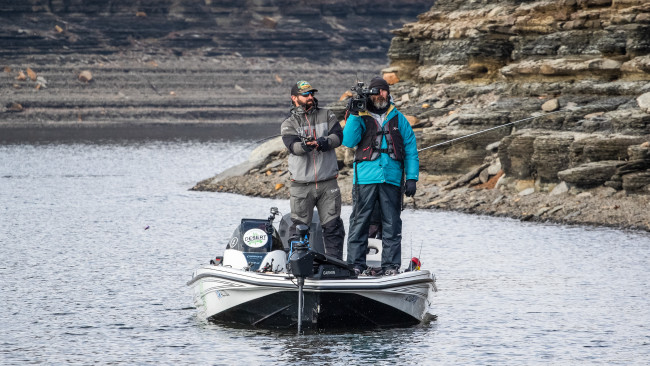
7. Caruso makes the long run south
Peoria, Arizona pro Michael Caruso spent all his time at the lower end of the lake near the dam in search of steep banks that featured some big boulders, which he says was key to finding his fish.
“The darker black slate with the boulders mixed in where they came all the way down to the water seemed to be key for me,” he explains. “If wind was blowing on them, that was a plus.”
Caruso’s dad, Kevin (who also fished the event as a boater), clued his son in on the pattern, which Michael says allowed him to mark a bunch of areas at the lower end on the final day of practice to run during the event.
The younger Caruso specifically liked the lower end of the lake for the little bit of stain on the water, which limited visibility to about 4 feet. Unfortunately, his water cleared up a bit on day three – something he says was probably a factor behind managing just two keepers for 6 pounds on the final day.
Caruso says he “lived and died” by a SPRO RkCrawler 55 in the electric shad color, which he admits is the color he had the most confidence in. He fished his crankbait on a pair of Megabass rods – an Orochi and a Levante – paired with Daiwa reels and 12-pound-test Seaguar fluorocarbon.
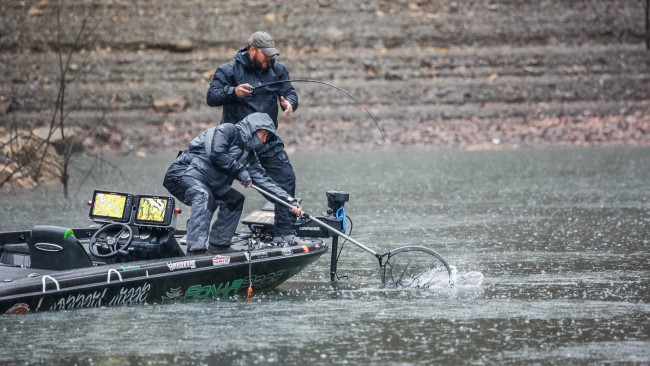
8. Palmer runs Ebare’s pattern but with a different bait
Like Ebare, Trent Palmer focused his efforts near the lower end of the lake (in Beaver Creek) along the first few points within the creek. Instead of using a Carolina rig, though, he opted for a SPRO RkCrawler 55 to do his damage.
To expand on his pattern, Palmer specifically targeted secondary points near the mouth of Beaver Creek that featured transitions – “do-nothing banks” that had some clumps of rock or isolated boulders.
Fishing in the lower end of the lake was simply a familiarity thing for the Cumming, Georgia pro.
“I had practiced in the lower end of the lake because clearer, deeper water is where I’m confident, being from the Lake Lanier area,” he explains.
The first couple days, Palmer says he was catching between 15 and 20 fish a day. On day three, his pattern dried up and he managed just two fish for 4-5, though the result was still a top-10 finish and a $12,000 payday.
Palmer caught 95 percent of his fish on the SPRO RkCrawler 55 in red bug, which he worked especially fast and fished on a 7-foot ALX rod and a 7:1 gear ratio reel. He also caught a couple fish on a Rapala DT 14 in red craw using the same setup.
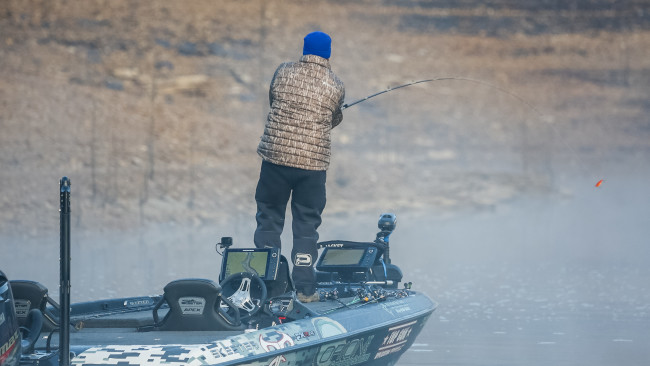
9. Eubanks goes the extra mile
While most everyone else was plying the waters near the mouths of creeks or on the main lake, Hunter Eubanks decided to get away from the crowd and make his way into the backs of those same creeks.
“It looked right,” he says. “I really just ran what looked right. It’s hit or miss trying to catch one. Everybody’s fishing the bluffs and at the mouths, so I went in the back and nobody was in the back.”
Eubanks specifically had some luck on bluff walls near the backs of the creeks, which he says wasn’t necessarily by design; he was simply covering water and tended to get bit better on those bluff walls. Unfortunately, on day three, with fog blanketing Faubush Creek where he began his day, Eubanks had to stop halfway back and missed out on his best bluff wall after a local boat hit that stretch well ahead of him.
Eubanks did his damage on day two with a 3/4-ounce football jig in a Cumberland craw color, so he began day three with the same bait and vastly different results. Switching to a custom-painted Rapala DT 10, he cranked up one fish for 3-9. Otherwise, he caught the rest of his fish on a BOOYAH One Knocker lipless crankbait, which he threw on a Bass Pro Shops Crankin’ Stick. He fished all of his baits on 15-pound-test Seaguar Red Label fluorocarbon.
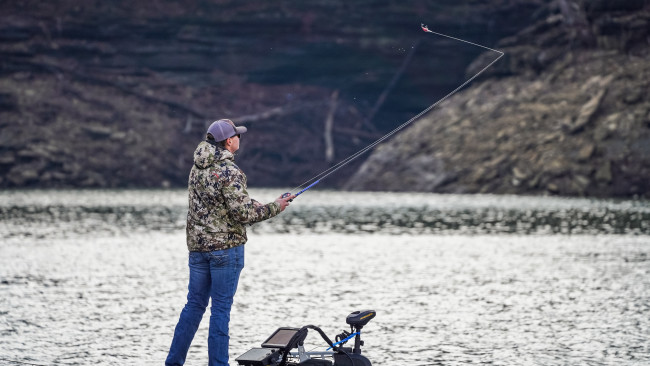
10. Loberg follows channel swings in main river
Andrew Loberg opted to stay on the main lake because he knew, with foul weather in the forecast, those waters would likely be the most consistent day over day. On the main river in the mid-lake area near Conley Bottom, he looked for channel swings, but not quite in the traditional sense.
“I was following the swings in the main river channel, but instead of fishing the actual hard river channel, they more located before and after the swings hit the bank,” he says. “I narrowed it down more too, with differences in the bank within that – any little pocket and point there was some fish.”
The first two days, Loberg employed a pair of custom-made brown-and-orange jigs (3/8- and 1/2-ounce) with a Zoom Super Chunk trailer, which he fished on Powell rods, Daiwa reels and P-Line fluorocarbon. On day two, though, he was getting fewer and fewer shallow bites, so Loberg switched to a SPRO RkCrawler 55 and Rapala DT10 and leaned on them throughout the final day as well.
“In practice, a lot of fish were shallow, and they were biting in 1 foot to 3 feet of water,” he says. “As the tournament progressed, I was getting fewer and fewer bites. Day two, in the afternoon, I switched to a crankbait. I think those fish pulled off a bit. That’s how I got them to bite. Day three, they weren’t doing either for me. I think they were suspended doing something different.”